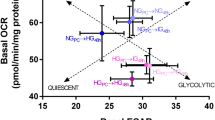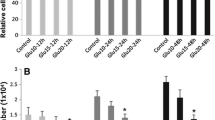Summary
Exposure to hyperglycemia slows the rate of proliferation of cultured human endothelial cells. Recently, it has been reported that glucose may autoxidize generating free radicals which have been hypothesized to delay cell replication time.
To test whether oxidative stress has an effect on delaying cell replication time in hyperglycemic conditions, human endothelial cells cultured from umbilical veins were incubated in 5 or 20 mM glucose, either alone or in the presence of one of three different antioxidants: superoxide dismutase (SOD), catalase and glutathione (GSH). Cells grown in medium with 5 mM glucose, with or without antioxidants, yielded similar population doubling times and cell cycle phase distributions. Significantly lower growth parameters were observed in cells grown in medium with 20 mM glucose, without antioxidants. The presence of the antioxidant reverted them to almost normal growth.
These data show that high glucose levels may delay endothelial cells replication time through the generation of free radicals, suggesting a possible pathophysiological linkage between the high levels of glucose and the development of microvascular complications of diabetes, possibly suggesting a new therapeutic approach to prevent such complications.
Similar content being viewed by others
References
Andreoli, S. P.; McAteer, J. A. Reactive oxygen molecule-mediated injury in endothelial and renal tubular epithelial cells in vitro. Kidney Intern 38:785–794; 1990.
Baish, H.; Gohde, W.; Linden, W. Analysis of PCP-date to determine the fractions of cell in the various phase of cell cycle. Radiat. Environ. Biophys. 12:31–42; 1975.
Baynes, J. W. Role of oxidative stress in development of complications in diabetes. Diabetes 40:405–412; 1991.
Bellomo, G.; Mirabelli, F.; Di Monte, D., et al. Formation and reduction of glutathione-protein mixed disulfide during oxidative stress. A study with isolated hepatocytes and menadione (2-methyl-1,4-napthoquinone). Biochem. Pharmacol. 36:1313–1319; 1987.
Borg, L. A. H.; Eriksson, V. J. Protection by free radical scavenging enzymes against glucose-induced embryonic malformations in vitro. Diabetologia 34:325–331; 1991.
CellFIT Software User’s Guide, May 1990, Becton Dickinson.
Ceriello, A.; Giugliano, D.; Quatraro, A., et al. Metabolic control may influence the increased superoxide generation in diabetic serum. Diabetic Medicine 8:540–542; 1991.
Di Monte, D.; Ross, D.; Bellomo, G., et al. Alterations in intracellular thiol homeostasis during the metabolism of menadione by isolated rat hepatocytes. Arch. Biochem. Biophys. 235:334–342; 1984.
Di Monte, D.; Bellomo, G.; Thor, H., et al. Menadione-induced cytotoxicity is associated with protein thiol oxidation and alteration in intracellular Ca2+ homeostasis. Arch. Biochem. Biophys. 235:343–350; 1984.
Fridovich, I. The biology of oxygen radicals. The superoxide radical is an agent of oxygen toxicity; superoxide dismutase provide an important defense. Science 201:875–880; 1978.
Halliwell, B.; Gutteridge, J. M. C. Lipid peroxidation, oxygen radicals, cell damage and antioxidants therapy. Lancet 1:1396–1397; 1984.
Hardenschild, C. C. Biology of endothelial cells. In: Jaffe, E. A., ed. Boston: Nijhoff; 1984:129–140.
Hunt, J. V.; Dean, R. T.; Wolff, S. P. Hydroxyl radical production and autoxidative glycosylation. Glucose autoxidation as the cause of protein damage in the experimental glycation model of diabetes mellitus and aging. Biochem. J. 256:205–212; 1988.
Jones, D. P.; Eklow, L.; Thor, H., et al. Metabolism of hydrogen peroxide in isolated hepatocytes: relative contributions of catalase and glutathione peroxidase in decomposition of endogenously-generated H2O2. Arch. Biochem. Biophys. 210:505–513; 1981.
Lorenzi, M.; Cagliero, E.; Toledo, S. Glucose toxicity for human endothelial cells in culture. Diabetes 34:621–627; 1985.
Lorenzi, M.; Nordberg, J. A.; Toledo, S. High glucose prolongs cell cycle traversal of cultured human endothelial cells. Diabetes 36:1261–1267; 1987.
Lorenzi, M.; Cagliero, E.; Markey, B., et al. Interaction of human endothelial cells with elevated glucose concentrations and native and glycosylated low density lipoproteins. Diabetologia. 26:218–222; 1984.
Mello Filho, A. C.; Hoffman, M. E.; Menghini, R. Cell killing and DNA damage by hydrogen peroxide are mediated by intracellular iron. Biochem. J. 218:273–280; 1984.
Mizrachi, Y.; Lelkes, P. J.; Ornberg, L. R., et al. Specific adhesion between pheocromocytoma (PC12 cells) and adrenal medullary endothelial cells in co-culture. Cell Tissue Res. 256:356–372; 1989.
Nicotera, P.; Moore, M.; Bellomo, G., et al. Demonstration and partial characterization of the glutathione disulfide-stimulated ATPase activity in the plasmamembrane fraction from rat hepatocytes. J. Biol. Chem. 260:1999–2005; 1985.
Oberley, L. W. Free radicals and diabetes. Free Rad. Biol. Med. 5:113–124; 1988.
Platt, J. T.; Michel, A. F. Retardation of fading and enhancement of intensity of immunofluorescence by p-phenylendiamine. J. Histochem. Cytochem. 31:840–842; 1983.
Rajeswari, P.; Natarajan, R.; Nadler, J. L., et al. Glucose induces lipid peroxidation and inactivation of membrane-associated ion transport enzymes in erythrocytes in vivo and vitro. Diabetes 40 (suppl.):10A; 1991.
Sato, Y.; Holta, N.; Sakamoto, N., et al. Lipid peroxide levels in serum of diabetic patients. Biochem. Med. 21:104–107; 1979.
Stortz, H.; Jelke, E. Photomicrography of weakly fluorescent objects —employment of p-phenylene diamine as a blocker of fading. Acta Histochem. 75:133–139; 1984.
Streeten, E. A.; Curcio, F.; Ornberg, R. L., et al. Cloned endothelial cells from fetal bovine bone. Proc. Natl. Acad. Sci. USA 86:916–920; 1989.
Wayne, W. D. Biostatistics: a foundation for analysis in the health sciences, 3rd ed. New York, NY: John Wiley & Sons; 1983:230–237.
Wilbur, K. M.; Wolfson, N.; Keneston, C. B., et al. Inhibition of cell division by ultraviolet irradiated unsaturated fatty acid. Exp. Cell Res. 13:503–509; 1957.
Wolff, S. P.; Dean, R. T. Glucose autoxidation and protein modification. The potential role of ‘autoxidative’ glycosylation in diabetes. Biochem. J. 245:243–250; 1987.
Wolfson, N.; Wilbur, K. M.; Beruheim, F. Lipid peroxide formation in regenerating rat liver. Exp. Cell Res. 10:556–558; 1956.
Author information
Authors and Affiliations
Rights and permissions
About this article
Cite this article
Curcio, F., Ceriello, A. Decreased cultured endothelial cell proliferation in high glucose medium is reversed by antioxidants: New insights on the pathophysiological mechanisms of diabetic vascular complications. In Vitro Cell Dev Biol - Animal 28, 787–790 (1992). https://doi.org/10.1007/BF02631069
Accepted:
Issue Date:
DOI: https://doi.org/10.1007/BF02631069




